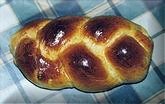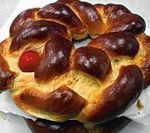 Tsoureki
Tsoureki|
From Wikipedia the free encyclopedia, by MultiMedia |
Tsoureki, (Greek: Τσουρέκι), also known as Lambropsomo, (Greek: λαμβροψομο), is a sweet bread which is a traditional Greek cuisine and Cypriot cuisine specialty for Easter, (Greek: Πάσχα-Pascha, meaning passover), with a red-dyed egg baked into the top. Similar rich brioche-like breads (often braided) are known by various different Greek names that represent three major holidays for Greeks: Easter, Christmas and New Year's. During Christmas its called Christopsomo, (Greek: Χριστόψωμο), which means Christ's Bread. For New Year's it is known as Vasilopita, Greek: Βασιλόπιτα, (also spelled Basilopita, Vassilopitta, or Vasilopeta), the traditional cutting of the Basilopita is to celebrate the coming of the New Year.
Such rich brioche-like breads are also traditional in many other countries, such as Hungary, the Czech Republic; known as çörek in Turkish cuisine; badnji kruh in Croatian cuisine; colomba di pasquain in the Portugese cuisine; choreg in Armenian cuisine; kulich in Russian cuisine; anise in Italian cuisine and Challah in Jewish cuisine.
 Tsoureki/Lambropsomo circle shaped w/red egg
Tsoureki/Lambropsomo circle shaped w/red egg
Τσουρέκι/λαμβροψομο: symbolizing the resurrection of Christ. Tsoureki is the Greek word for its Turkish derived word which means "that which is kneaded". The Greek word Lambropsomo is a combination of two words: lambro (Greek: λαμβρο) which means "bright light"; and psomo (Greek: ψομο) which means bread: lambropsomo translates to shining-bread or the epiphany-bread, representing the light given to Christians by Christ's resurrection and the passing over from what we are to what Rison Lord wants us to be: "partakers of divine nature". This braided bread can be shaped either into a circle or into two large braids and sprinkled with sesame seeds. It is adorned with beautiful red Easter eggs and sometimes red rosebuds for decorations. The Easter eggs are dyed deep red to represent the blood of Christ, the eggs also represent new life and springtime. It is traditionally eaten during the Resurrection Meal. After 40 days of fasting - as is dictated by the Greek Orthodox Church (but rarely followed as strictly by the general population any longer) - the Easter feast has to begin slowly, with a light meal after the midnight liturgy on Saturday night. The fast is generally broken with magiritsa, an offal-based soup flavored with avgolemono sauce; tsoureki, the fluffy, egg-laden Easter bread, salad and a bowl of red dyed eggs. Greeks have a custom when it comes to the eggs: they crack them one-to-one. Whosever egg remains in tact, supposedly has good luck in the ensuing year.
This bread recipe was traditionally prepared with an essence drawn from the seeds of Mediterranean wild cherries, called makhlepi, (Greek: μαχλέπι), which makes the kitchen smell delicious. The kernels of the makhlepi cherry spice are loved for specialties like tsoureki, but some people at times may elect to prepare this beautiful bread without the seed essence. Besides mahaleb kernels, the bread can be flavoured with mastic, the resin from Pistacia lentiscus var; chia which is used only in Greek cuisine. In more recent years, vanilla-scented tsoureki has also become quite popular. Sometime tsoureki is used as gifts for special occasion, for instance, it can be given as an Easter gift from children to their godparents.
Χριστόψωμο: is a Greek bread decorated with an early form of the Christian cross with ends that split and curl into circles. Sometimes initials, birth dates and ages are added to celebrate all occasions. It is a rich, round loaf scented with wine soaked figs, anise,orange and it sometimes contains mastiihi, a dried pine resin. The bread is sometimes served with honey on Christmas eve. Families leave pieces of bread on the table believing that Christ will come and eat them during the night.
During the 40 days of fasting, special loaves of Christopsomo, which translates to Christ's Bread, are prepared for the meals. The loaves are round and decorated with a cross, which people make symbols shaped in dough. It is considered a sacred tradition in Greek Orthodox homes, and the care with which it is made is said to ensure the well-being of the home in the year to come. Only the purest and most expensive ingredients are used. The bread is often decorated with pieces of dough formed into representations of the family's life. Traditionally on Christmas Eve every household would bake a Christopsomo and then decorated with engravings on the crust that represent aspects of the family's life and profession.
In earlier times, Greek cooks baked large quantities of bread to last for 10-15 days, so baking just one or two loaves of Christopsomo the night before Christmas had special significance. The cook would start by crossing him/herself before starting the preparations, making this Christmas bread, which still is - considered by many to be a sacred task and great care is taken in its preparation. Raisins, nuts, cinnamon, cloves, and nutmeg are just a few of the taste treats that some recipes use for this traditional loaf.
Βασιλόπιτα: On New Year's Day families cut the Vassilopitta to bless the house and bring good luck for the new year. A coin is wrapped and hidden in the bread by slipping it into the bottom before serving. A piece of cake is sliced for each member of the family and any visitors present at the time, in order of age. Pieces are also sliced for the Church, the poor, and the Kallikantzaroi, (Greek: Καλλικάντζαρος), commonly translated as goblins. [1]
The word Vasilopita is compound by the Greek word for bread and the name Basil (Greek: Βασιλι; Vasili) ; the word Βασιλόπιτα means the sweet bread of Basil, dedicated to Saint Basil, the first person in human history to establish an orphanage for little children. He also founded the first Christian hospital in the world. His fame as a Holy Man spread like wildfire throughout the Byzantine world. One of the most beautiful and inspiring traditions and customs of the Greek Orthodox Church is the observance of the Vasilopita. It is this annual family observance, together with many other traditions which joins our Orthodox Faith and heritage with the history of the Christian religion itself.
This age old tradition commenced in the 4th century, when Saint Basil the Great, who was a bishop, wanted to distribute money to the poor in his Diocese. He commissioned some women to bake sweetened bread, in which he arranged to place gold coins. Thus the families in cutting the bread to nourish themselves, were pleasantly surprised to find the coins. Saint Basil's Feast Day is observed on January 1, the beginning of the New Year and the Epiphany season known as the Vasilopita Observance. This original event which happened in Cappadocia of Caesarea in the last half of the 4th century, is very much alive in Greek Orthodox homes each year on January 1st. According to tradition, the Vasilopita, special sweet bread (in some areas of Greece, it takes the form of a cake) is prepared both in the Orthodox homes and in the Church community. Sweets are added to the bread which symbolize the sweetness and joy of life everlasting. It also symbolizes the hope that the New Year will be filled with the sweetness of life, liberty, health, and happiness for all who participate in the Vasilopita Observance. When the Vasilopita is prepared, a coin is usally added to the ingredients. When the bread is cut and the observance begins, the individual who receives that portion of the Pita which contains the coin is considered blessed for the year.
This tradition adds joy to the celebration at the beginning of the New Year, which everyone hopes will bring joy to all. Many Orthodox Christians enjoy the Vasilopita at home with their loved ones during the New Year celebration. The head of the family cuts the pieces of pita for all members of the family. Since Saint Basil loved the poor people, a special piece is cut for the unfortunate of the world, which symbolizes the concern for the poverty-striken people of all nations.
Along with the feast of Saint Basil, is the observance of the civil New Year. These two observances are commemorated with the singing of the "Kalanta" (carol-type songs) which speak both of the New Year and the great bishop, Saint Basil. The Kalanta are part of the Vasilopita Cutting in each home on New Year's/Saint Basil's Day. The words stress the joy and excitement of the New Year which brings new opportunities, the love of Christ, His miraculous Birth, His Baptism, and the compassion of the pious Saint Basil who brought so much joy and happiness to the world. They ask Saint Basil to stay a while at their home, to partake of their meal and fellowship, and to grant them "good cheer".
In a bowl, combine 10 cups of the flour and salt, and add melted butter. Boil mahlab (mahlepi) in 2 cups of water, strain, and add the liquid to the flour. (Alternatively, add 1 teaspoon of mahlepi or other flavoring + 2 cups of liquid - 1 cup each of orange juice, milk or water.)
Add the eggs, mastic, sugar, and the risen yeast mixture. On a floured surface or in a mixer, knead the mixture well, adding in remaining flour until it becomes a malleable dough, about 15-20 minutes (or 10 minutes with a mixer). Cover and allow to rise in a warm place until doubled in bulk (1 1/2 - 2 hours).
Punch down the dough and create shapes:
Place the loaves on greased cookie sheets or baking pans, cover, and allow to rise in a warm place until doubled in bulk. Brush with egg wash.
Preheat oven to 350°F (175°C).
(Optional) Sprinkle with sugar, sesame seeds, or blanched almond slices.
Bake at 350°F (175°C) for 30 minutes or until golden brown. (Tap on the bottom; they should sound hollow.) Cool for 5 minutes, then move to racks to cool completely.
Yield: 4 to 6 loaves